RNA secondary structure at the transcription start site influences EBOV transcription initiation and replication in a length- and stability-dependent manner
- PMID: 32882148
- PMCID: PMC7971292
- DOI: 10.1080/15476286.2020.1818459
RNA secondary structure at the transcription start site influences EBOV transcription initiation and replication in a length- and stability-dependent manner
Abstract
Ebola virus (EBOV) RNA has the potential to form hairpin structures at the transcription start sequence (TSS) and reinitiation sites of internal genes, both on the genomic and antigenomic/mRNA level. Hairpin formation involving the TSS and the spacer sequence between promotor elements (PE) 1 and 2 was suggested to regulate viral transcription. Here, we provide evidence that such RNA structures form during RNA synthesis by the viral polymerase and affect its activity. This was analysed using monocistronic minigenomes carrying hairpin structure variants in the TSS-spacer region that differ in length and stability. Transcription and replication were measured via reporter activity and by qRT-PCR quantification of the distinct viral RNA species. We demonstrate that viral RNA synthesis is remarkably tolerant to spacer extensions of up to ~54 nt, but declines beyond this length limit (~25% residual activity for a 66-nt extension). Minor incremental stabilizations of hairpin structures in the TSS-spacer region and on the mRNA/antigenomic level were found to rapidly abolish viral polymerase activity, which may be exploited for antisense strategies to inhibit viral RNA synthesis. Finally, balanced viral transcription and replication can still occur when any RNA structure formation potential at the TSS is eliminated, provided that hexamer phasing in the promoter region is maintained. Altogether, the findings deepen and refine our insight into structure and length constraints within the EBOV transcription and replication promoter and suggest a remarkable flexibility of the viral polymerase in recognition of PE1 and PE2.
Keywords: EBOV 3ʹ-leader promoter; RNA stabilization of hairpin structures at the transcription start site (TSS); Viral transcription and replication; expansion of the spacer between PE1 and PE2.
Conflict of interest statement
No potential conflict of interest was reported by the authors.
Figures
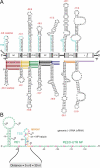
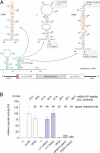
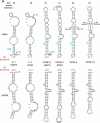


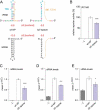
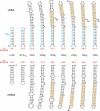

Similar articles
-
Regulation of VP30-Dependent Transcription by RNA Sequence and Structure in the Genomic Ebola Virus Promoter.J Virol. 2021 Mar 1;95(5):e02215-20. doi: 10.1128/JVI.02215-20. Epub 2020 Dec 2. J Virol. 2021. PMID: 33268520 Free PMC article.
-
Hexamer phasing governs transcription initiation in the 3'-leader of Ebola virus.RNA. 2020 Apr;26(4):439-453. doi: 10.1261/rna.073718.119. Epub 2020 Jan 10. RNA. 2020. PMID: 31924730 Free PMC article.
-
RNA binding specificity of Ebola virus transcription factor VP30.RNA Biol. 2016 Sep;13(9):783-98. doi: 10.1080/15476286.2016.1194160. Epub 2016 Jun 17. RNA Biol. 2016. PMID: 27315567 Free PMC article.
-
The marburg virus 3' noncoding region structurally and functionally differs from that of ebola virus.J Virol. 2009 May;83(9):4508-19. doi: 10.1128/JVI.02429-08. Epub 2009 Feb 18. J Virol. 2009. PMID: 19225002 Free PMC article.
-
Transcription start site choice regulates HIV-1 RNA conformation and function.Curr Opin Struct Biol. 2024 Oct;88:102896. doi: 10.1016/j.sbi.2024.102896. Epub 2024 Aug 14. Curr Opin Struct Biol. 2024. PMID: 39146887 Review.
Cited by
-
New Perspectives on the Biogenesis of Viral Inclusion Bodies in Negative-Sense RNA Virus Infections.Cells. 2021 Jun 10;10(6):1460. doi: 10.3390/cells10061460. Cells. 2021. PMID: 34200781 Free PMC article. Review.
-
Regulation of VP30-Dependent Transcription by RNA Sequence and Structure in the Genomic Ebola Virus Promoter.J Virol. 2021 Mar 1;95(5):e02215-20. doi: 10.1128/JVI.02215-20. Epub 2020 Dec 2. J Virol. 2021. PMID: 33268520 Free PMC article.
-
The International Virus Bioinformatics Meeting 2023.Viruses. 2023 Sep 30;15(10):2031. doi: 10.3390/v15102031. Viruses. 2023. PMID: 37896809 Free PMC article.
-
Molecular mechanism of de novo replication by the Ebola virus polymerase.Nature. 2023 Oct;622(7983):603-610. doi: 10.1038/s41586-023-06608-1. Epub 2023 Sep 12. Nature. 2023. PMID: 37699521
-
Designing a novel multi‑epitope vaccine against Ebola virus using reverse vaccinology approach.Sci Rep. 2022 May 11;12(1):7757. doi: 10.1038/s41598-022-11851-z. Sci Rep. 2022. PMID: 35545650 Free PMC article.
References
-
- Malvy D, McElroy AK, de Clerck H, et al. Ebola virus disease. Lancet. 2019;393:936–948. - PubMed
Publication types
MeSH terms
Substances
LinkOut - more resources
Full Text Sources
Other Literature Sources
Medical
Research Materials
